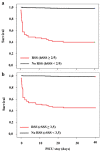Refractory septic shock in children: a European Society of Paediatric and Neonatal Intensive Care definition
- PMID: 27709263
- PMCID: PMC5106490
- DOI: 10.1007/s00134-016-4574-2
Refractory septic shock in children: a European Society of Paediatric and Neonatal Intensive Care definition
Abstract
Purpose: Although overall paediatric septic shock mortality is decreasing, refractory septic shock (RSS) is still associated with high mortality. A definition for RSS is urgently needed to facilitate earlier identification and treatment. We aim to establish a European society of paediatric and neonatal intensive care (ESPNIC) experts' definition of paediatric RSS.
Methods: We conducted a two-round Delphi study followed by an observational multicentre retrospective study. One hundred and fourteen paediatric intensivists answered a clinical case-based, two-round Delphi survey, identifying clinical items consistent with RSS. Multivariate analysis of these items in a development single-centre cohort (70 patients, 30 % mortality) facilitated development of RSS definitions based on either a bedside or computed severity score. Both scores were subsequently tested in a validation cohort (six centres, 424 patients, 11.6 % mortality).
Results: From the Delphi process, the draft definition included evidence of myocardial dysfunction and high blood lactate levels despite high vasopressor treatment. When assessed in the development population, each item was independently associated with the need for extracorporeal life support (ECLS) or death. Resultant bedside and computed septic shock scores had high discriminative power against the need for ECLS or death, with areas under the receiver operating characteristics curve of 0.920 (95 % CI 0.89-0.94), and 0.956 (95 % CI 0.93-0.97), respectively. RSS defined by a bedside score equal to or higher than 2 and a computed score equal to or higher than 3.5 was associated with a significant increase in mortality.
Conclusions: This ESPNIC definition of RSS accurately identifies children with the most severe form of septic shock.
Keywords: Acidosis; Cardiac; Failure; Lactic; Paediatrics; Resuscitation; Septic; Shock.
Conflict of interest statement
Compliance with ethical standards Funding None. Conflicts of interest Dr. Javouhey reports grants from CSL Behring, personal fees from Gambro-Baxter, outside the submitted work. Dr. Tissieres reports grants from Merieux Foundation, non-financial support from Chiesi Inc, outside the submitted work. All other authors declare that they have no conflict of interest.
Figures



References
-
- Liu L, Johnson HL, Cousens S, Perin J, Scott S, Lawn JE, Rudan I, Campbell H, Cibulskis R, Li M, Mathers C, Black RE. Child health epidemiology reference group of WHO and UNICEF global, regional, and national causes of child mortality: an updated systematic analysis for 2010 with time trends since 2000. Lancet. 2012;379:2151–2161. doi: 10.1016/S0140-6736(12)60560-1. - DOI - PubMed
-
- Schlapbach LJ, Straney L, Alexander J, MacLaren G, Festa M, Schibler A, Slater A, ANZICS Paediatric Study Group Mortality related to invasive infections, sepsis, and septic shock in critically ill children in Australia and New Zealand, 2002–13: a multicentre retrospective cohort study. Lancet Infect Dis. 2015;15:46–54. doi: 10.1016/S1473-3099(14)71003-5. - DOI - PubMed
Publication types
MeSH terms
Substances
LinkOut - more resources
Full Text Sources
Other Literature Sources

